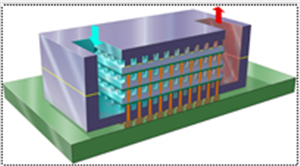IBM cools chips with 'tiny rivers' of H2O; Aims to stretch Moore's Law

IBM Labs is taking water cooling to another level--and pumping water into each layer of a semiconductor via pipes as thin as a human hair.

If all goes well, IBM predicts that it can advance Moore's Law into the next decade and cut the electric bill of data centers, which are power intensive. IBM's news (statement) is the latest in a bevy of green data center announcements.
Here's the IBM explanation:
These so-called 3-D chip stacks -- which take chips and memory devices that traditionally sit side-by-side on a silicon wafer and stacks them together on top of one another -- presents one of the most promising approaches to enhancing chip performance beyond its predicted limits.
This follows IBM's leadership in advancing chip-stacking technology in a manufacturing environment a year ago, which shortens the distance information on a chip needs to travel by 1000 times, and allows for the addition of up to 100 times more channels, or pathways, for that information to flow compared to 2-D chips.
In English, IBM is taking cooling to the root of the energy problem--the semiconductor. In theory, IBM is dissipating heat at the chip-level so you won't need as much air conditioning too cool them.
Among the key points of IBM's experiment:
- IBM's scientists piped water through a 1 by 1 cm test vehicle, consisting of a cooling layer between two dies or heat sources. The cooling layer is 100 microns in height and has 10,000 vertical interconnects per cm2.
- The water pipes are hermetically sealed to prevent electrical shorts. IBM likened the system to a human brain where neurons are firing, but don't interfere with blood vessels.
- These water cooled layers were produced with current manufacturing methods except for the tools needed to etch and drill the interconnections.
- To assemble the layers, IBM's team developed a thin-film soldering technique.
The next step for IBM is to optimize cooling systems for smaller chips and more interconnects. There's no word on when this research may actually make it into a product.